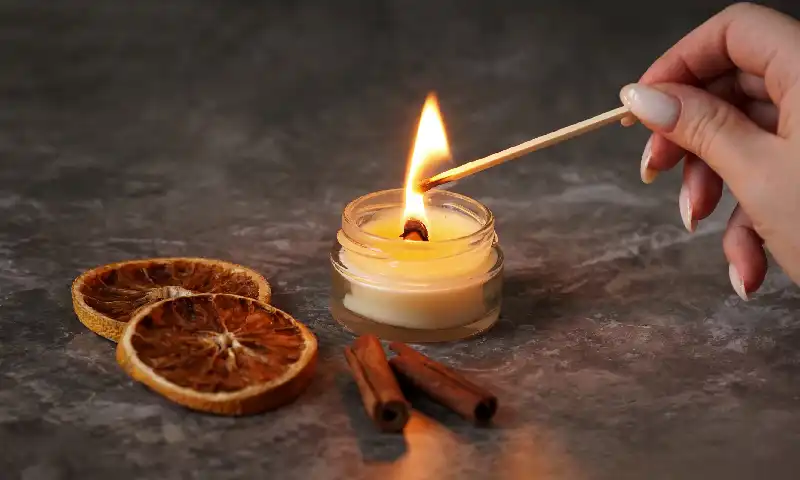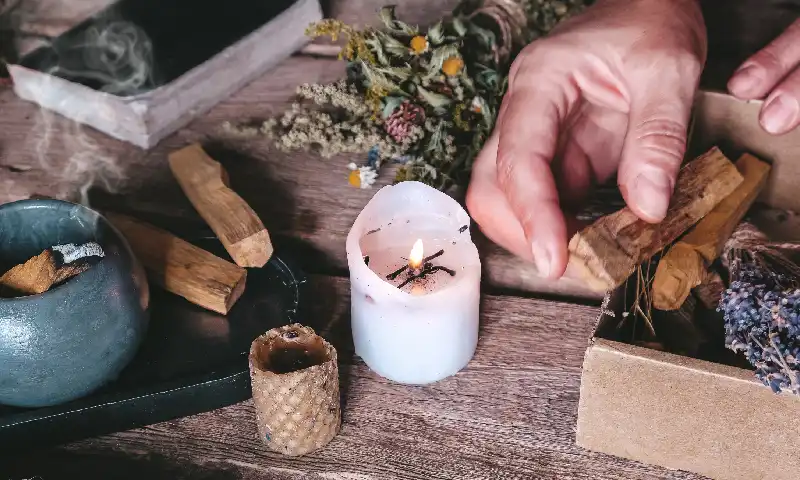Table of Contents
Introduction
Candles have been a source of warmth and a cozy atmosphere in our homes for many centuries. But, there’s a deeper story to explore. Come with us on a voyage to uncover the fascinating science of candle burning and how the use of essential oils, like in the popular Mahogany Teakwood candle, enhances the experience. Let’s delve into the fascinating chemistry that not only illuminates your space but also fills it with captivating fragrances.

Why Candles Burn
The Chemistry Behind It
Candles consist of substances such as paraffin wax or beeswax, both of which contain hydrocarbons. These hydrocarbons serve as the candle’s source of fuel.Sparking the Fire
When you light a candle’s wick, the heat from the flame melts a bit of the wax, creating a pool of liquid fuel.Oxygen’s Vital Role
Oxygen from the air is a crucial player. It combines with the hydrocarbons in the wax to create heat, light, carbon dioxide, and water vapor.Wick’s Part
The wick is where it all starts. It provides the path for the melted wax to travel up and meet the oxygen.

How a Candle Burns Without Essential Oil
When you light a candle without essential oil, the main elements at the core of the candle, like the wax and the wick, are primarily engaged in the combustion process. Here’s a detailed explanation for you:
Wick Ignition
When you light the candle’s wick, the heat from the flame melts a small portion of the wax near the wick. This creates a pool of liquid fuel at the candle’s center.Oxygen’s Role
Oxygen from the surrounding air plays a crucial role. It combines with the hydrocarbons present in the wax to facilitate combustion. This chemical reaction generates heat and light.Flame Formation
The combustion of the hydrocarbon gases produced by the melted wax results in a visible flame. This flame emits heat and light, providing the illumination associated with a burning candle.Sustaining the Flame
The heat generated by the flame travels down the wick, melting more wax, and turning it into vapor. This process ensures a continuous supply of fuel for the flame, allowing the candle to burn.Byproducts of Combustion
As the chemical reaction advances, it generates secondary substances, specifically carbon dioxide (CO2) and water vapor (H2O). These gases are then emitted into the nearby surroundings.Extinguishing the Candle
When you extinguish the candle, either by blowing it out or when it runs out of fuel, the heat source is removed. The wax cools and solidifies, ceasing the combustion process until the candle is relit.

How a Candle Burns with Essential Oil
When you ignite a candle that contains essential oils, like a Mahogany Teakwood candle, the process of burning is essentially the same as with a standard candle. Nevertheless, there is an extra aromatic element thanks to the essential oil’s presence. Certainly, here’s the process:
Wick Ignition with Essential Oil
Lighting the wick of a Mahogany Teakwood candle generates heat, which not only melts the surrounding wax but also vaporizes the Mahogany Teakwood essential oil contained in the candle.Enhancing the Aroma
The vaporized Mahogany Teakwood essential oil infuses the surrounding air with its delightful scent. This aromatic essence enhances the atmosphere, providing a pleasing and distinct fragrance to the candle’s illumination.The Fiery Chemistry with Mahogany Teakwood
The vaporized Mahogany Teakwood oil, mixed with the oxygen from the air, undergoes combustion. This combustion process results in the creation of the mesmerizing flame characteristic of Mahogany Teakwood candles.Flame Magic
The combustion of the Mahogany Teakwood-scented wax not only produces heat and light but also releases the signature aroma of Mahogany Teakwood. This combination of sensory experiences adds depth and charm to the candle’s ambiance.Maintaining the Flame
The heat from the flame continues to travel down the wick, melting more wax, and vaporizing the Mahogany Teakwood-infused components. This cyclical process ensures the continuous burning of the candle and the sustained release of its aromatic fragrance.Byproducts of Combustion
The chemical reaction in a Mahogany Teakwood-scented candle still produces carbon dioxide and water vapor as byproducts. However, in this case, the byproducts carry the delightful scent of Mahogany Teakwood.Extinguishing the Mahogany Teakwood Candle
When you extinguish the Mahogany Teakwood candle, the same principles apply. The heat source is removed, the wax cools, and the combustion process stops until the candle is relit. The aromatic memory of the Mahogany Teakwood lingers in the air.
Conclusion
In closing, as you light your next candle, you can now appreciate the profound chemistry that illuminates our lives, adding a layer of warmth and fragrance to our surroundings.
To learn more about the variety of scented candles available and their flame characteristics, explore The Candle Affair’s collection of hand-poured soy or beeswax candles. They use premium ingredients and offer a wide range of fragrances, from calming florals to invigorating citruses. Visit Thecandleaffair.com to discover your perfect candle and experience the transformative power of scent in your home.

